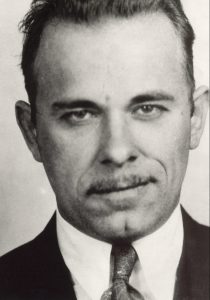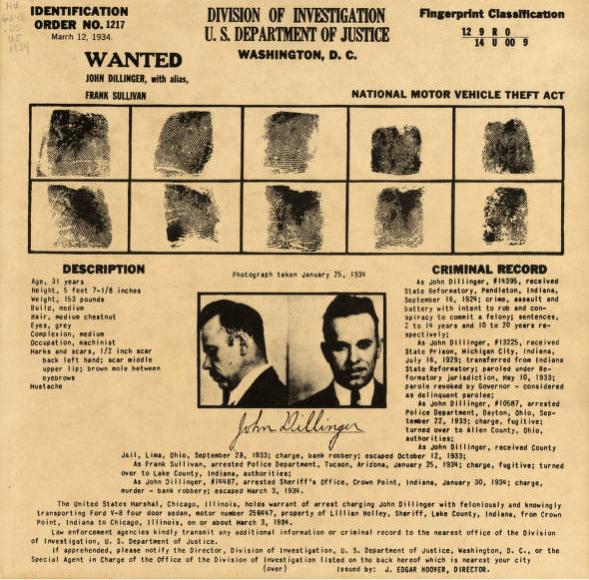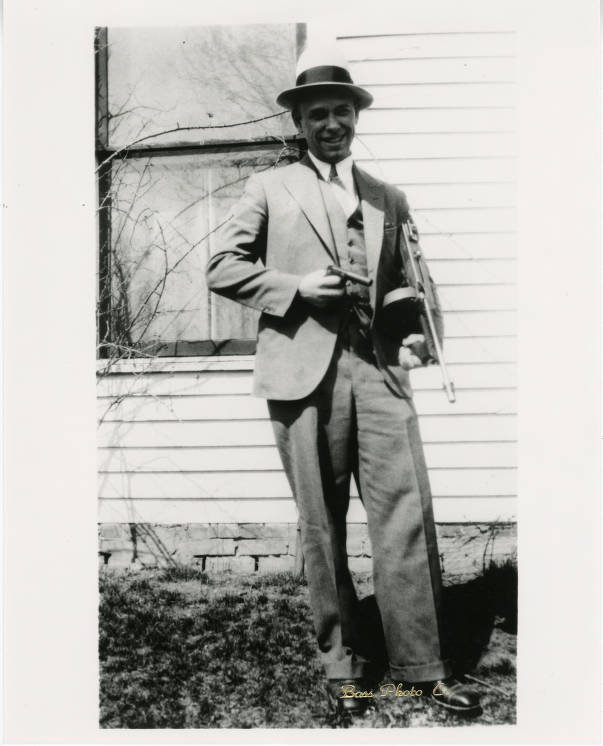
Photo info ...
Credit: FBI, Public domain, via Wikimedia CommonsView Source
(June 23, 1903-July 22, 1934). Born in Indianapolis to grocer John W. and Mollie Lancaster Dillinger, John grew up in the vicinity of 21st and Hillside streets. He attended public schools 38 and 55 but quit at age 16. He then worked briefly in a veneer mill, a westside machine shop, and as an errand boy for the Indianapolis .

In March, 1920, Dillinger’s family moved to , hometown of his widowed father’s new wife. Following his first crime (an auto theft) in July 1923, Dillinger joined the Navy and was stationed at the Great Lakes Naval Training Facility. After being assigned as a fireman on the USS Utah, he deserted the Navy in December, returned home, and married.
Dillinger began his criminal career with an attempted holdup of a Mooresville grocer in September 1924. Following his conviction, he spent 1924-1933 in Indiana state prisons, during which time his wife divorced him (1929) and he strengthened his criminal connections.

Paroled on May 22, 1933, within four months Dillinger successfully robbed numerous banks in Indiana, Ohio, and Michigan, including the Massachusetts Avenue State Bank in Indianapolis. On September 22, he was arrested and jailed in Ohio before escaping. Dillinger and his gang next robbed banks in Indiana and Wisconsin and raided police stations for automatic weapons, bulletproof vests, and police identification before fleeing south where they were arrested in Tucson, Arizona. Extradited to Crown Point, Indiana, Dillinger achieved his most celebrated escape on March 3, 1934, when he allegedly used a fake pistol carved from wood to force his way past a dozen jail guards.
In the ensuing months, the Indiana offered to arm its 30,000 members to patrol Hoosier highways, and the National Guard volunteered its aircraft for aerial patrols. Governor Paul McNutt agreed to increase expenditures for state police equipment while the informed the U.S. attorney general that the situation in Indiana was serious. In June 1934, the federal government posted a $10,000 reward for Dillinger’s capture.
After barely dodging the FBI in Minnesota and Wisconsin, Dillinger fell victim to a trap involving Anna Sage, a friend and brothel madam who became known as the “Lady in Red.” She drew him to the Biograph Theater in Chicago, on July 22, 1934, and upon exiting he was shot to death. Dillinger was buried in , despite protests from other plot owners. His grave continues to be one of the most visited in the cemetery.
In August 2019, John Dillinger again made the news when his nephew, Michael C. Thompson, filed a lawsuit against Crown Hill after cemetery officials opposed exhuming his body for a documentary in which the History Channel planned to participate.
Questions surrounding who was buried in the burial plot had become legendary. According to rumors, Dillinger had removed his fingerprints with acid, dyed his hair, and plucked his eyebrows into a fine line, leading some to believe that it was not Dillinger but a lookalike who had been shot in front of the Biograph. Crown Hill objected to the exhumation, and the FBI issued a statement confirming the identity of Dillinger at the time of his death. The History Channel dropped out of the project in September. In December, Marion County Superior Court Judge ruled in favor of Crown Hill. Criticized as a publicity stunt, the documentary project was abandoned following the ruling.

Help improve this entry
Contribute information, offer corrections, suggest images.
You can also recommend new entries related to this topic.